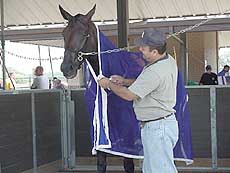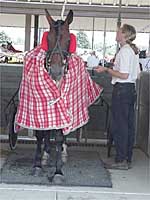|
Part
2
A look at the Illinois State Fair
[AUG.
16, 2000]
The
state fair has endured changes since its inception, when the primary
goal was to promote improved methods of farming and raising
livestock, along with methods of labor, industry, education, and
arts and sciences. In following years, the fair was at various
locations around the state, traveling from Alton to Freeport,
Decatur and Chicago, until making its permanent home in Springfield
in 1893. The fair has had its share of adjustments during its
century and a half in existence, enduring not only a rotating list
of sites and manager, but a Civil War, when premiums were awarded
but there was no general fair location.
|
|
Since
making its home at its current location on the north side of the
city, the fairgrounds have expanded and improved as the fair itself
has grown. The coliseum was built in 1901, with the dairy building,
main gate, sheep and swine pavilions, 18 horse barns and grandstand
all being added during the following 30 years.
The
opening of the first permanently located fair was Sept. 24, 1894,
and it ran for six days. Admission was 50 cents for adults, 75 cents
for one person on horseback, and $1.25 for a carriage load of four
people. Premiums totaled $30,000 for that year, and many of the
buildings on the fairgrounds were renovated.

Currently,
the fairgrounds cover 366 acres and accommodate approximately one
million visitors.
During
the fairís 10-day operation, it uses approximately 143 portable
sanitation units; 7,100 rolls of toilet paper; 4,207 bars of soap;
13 manure trucks during the night shift; nine end loaders for
manure, and 420 people hired to clean swine, horse, sheep, goat and
cattle barns. Sixty loads of manure are hauled away each day,
totaling 1,198 tons. A total of 400 tons of garbage are generated
during the fair.
The
fair has been self-sustaining with its own budget since 1996 and
operates according to its success the previous year. This yearís
fair has a $4 million budget.
"Our
success from one year depicts what we can do the next year. Last
year, we brought in $400,000 over what the budget was the previous
year, so we were in pretty good shape," Ford said. Last year,
an additional $300,000 was approved by the legislature for
grandstand entertainment, while operating capital was increased by
$200,000, and awards and premiums increased by $400,000, making the
budget for this yearís fair the highest in history.
(To top of second
column in this section)
|

Ford
said Illinois is considered one of the top fairs in the country in
terms of attendance figures, size and income, according to the
International Association of Fairs and Exhibitions.
The
fair is also fortunate to be blessed with a bevy of volunteers, who
work the information booth, serve as hosts and guides, and a variety
of other tasks throughout the fairgrounds. Despite the dwindling
reserve of local volunteers cited by other tourist attractions in
the city, Ford said the state fair has no problems enticing people
to work free.
"Eighty-five
percent of volunteers literally seek us out," he said.
"Every year the number increases. Thatís why we feel so
fortunate, because all we do is give them a couple of T-shirts. And
theyíre here, religiously, for 10 days."
Ford
said the fair faces competition not only from local county fairs or
other state fairs, but also from other entertainment venues in
Chicago and St. Louis, including casinos and concerts.

"I
donít see (other fairs) as being the competition. Thereís only X
amount of dollars people have for entertainment. Itís OK to have
that compassion. But what we have going for us is we charge $3
admission, with special days for less admission. We have 11 total
stages of entertainment, so you can come in there with a family of
four and have a wonderful experience for little dollars."
[Penny
Zimmerman-Wills]
|
|
|
Part
1
A look at the Illinois State Fair
[AUG.
15, 2000]
In
1853, members of the Illinois State Agriculture Society decided to
have an event to promote agriculture and mechanical art. Sangamon
County donated the use of 20 acres on Springfieldís west side and
contributed $1,000 to cover expenses. Prize money was awarded for
the best wine, rhubarb, peaches, ox yoke and portable grist mill.
Admission was 25 cents.
|
|
Now,
148 years later, the Illinois State Fair draws approximately one
million people to the city of Springfield, making it the leading
tourist attraction in the city and drawing as many people during its
10-day run as the Lincoln Home and Lincoln Tomb combined. But the
carnival rides, food and entertainment options are just as likely to
draw people to the fair these days as the livestock and produce
competition and farm equipment displays.

"The
major emphasis and participation from the agriculture community was
at its high when it began. In the early 1980s when there were a lot
of farmers going under, it diminished. Thatís where the challenge
is Ė I donít think it will ever have the same visibility it had
in the early days, because farmers are different. The challenge
before us is to at least have a pleasurable experience for the
person coming to the fair, but at the same time, educate them to the
plight of the farmer. We have an obligation," Bud Ford, state
fair manager, said.
Ford,
who is in his second year as manager, admits that attendance figures
are less than scientific, but says, "I know last year, the
first Saturday exceeded 160,000 people legitimately, and it was
probably the busiest weekend day they ever had. Everyone that comes
to the fair I view as a special interest. The agriculture community,
and rightly so, come here because itís a tradition, itís a
celebration. We have an obligation to put this on.
"Itís
more than just carnival rides, grandstand, livestock," he said.
"People get a twinkle in their eye when they start talking
about the fair. They canít tell me the one thing they like; itís
a happening. Itís a 10-day extravaganza in their mind, that they
look forward to, especially in this community."
Ford
said the biggest challenge facing the fairís success is an entity
left to chance Ė the weather. "Weíll exceed a million
(people) this year, weather permitting. We can do the best job we
can possibly do, but we canít control the weather. I told my staff
last year, donít get down if it rains 10 days or if itís too
hot. We can control what we offer and we can do publicity, but we
canít control the weather. This year, I feel we have exceeded even
my expectations. I didnít know how we would top last year,"
said Ford, who did have to watch a severe thunderstorm hit the
fairgrounds last year, during the opening night parade.

Agriculture
machinery exhibits and livestock judging are now just one part of
the fairís emphasis. Vendors sell a large variety of food items,
from the traditional corn dogs and lemonade shake-ups to Cajun
shrimp on a stick, turkey legs and alligator tail. A Taste of
Illinois tent was so successful in its first year at the fair last
year, itís been expanded and will offer more Illinois foods and
beverages and nightly music by Chicago blues bands. A new tent this
year sports a Key West theme, a personal request by Ford, who is a
Jimmy Buffet fan.
(To top of second
column in this section)
|
|
The Illinois
State Fair |
|
Address:
P.O. Box 19427, Springfield, IL 62794-9427
Phone:
217/782-6661
Fax:
217/782-9115
Web
site: www.state.il.us/fair/
E-Mail:
pio@agr.state.il.us
State
Fair Manager:
Bud Ford. The fair is a division under the Illinois Department
of Agriculture, director Joe Hampton.
Annual
budget: $4
million
Annual
attendance:
estimated one million people
Full-time
employees: 11
Part-time
employees hired by the state fair office during the fair:
300. The Department of Agricultureís building and grounds
department hires an additional 400 people.
Number
of volunteers:
150-200
Number
of animals:
12,000 species at any given time
Amount
of manure hauled away during the 10-day fair:
1,198 tons
|
The
fair also features a variety of music, food and events for people of
all ages Ė from Happy Hollow, with carnival games and rides to
cooking demonstrations and high-diving acts; baboons to ballroom
dancing; 4-H exhibits and pig racing to international cuisine and
wine judging.
Each
day of the fair focuses on a theme, including county fair and horse
racing; city of Chicago and local officials; veterans; senior
citizens; agriculture; the governor; Democrats; park district
conservation and family/violence prevention.

Some
people even go to the fair just to see the famous butter cow Ė an
unofficial icon of the fair since the 1920s. Five hundred pounds of
unsalted butter is used to sculpt the life-size figure by hand over
a wire and wood frame. The process takes about two days and is
featured in the dairy building.

Ford
said last year was the first year the grandstand made a profit.
"It had never paid for itself. The maximum it ever brought in
was $600,000 to $800,000. Last year, we brought in $1.7 million. Our
parking and gated admissions brought in an excess of $1 million.
Concession stands, which pay (the fair) 10 to 15 percent of their
profits, brought in over $1 million. Corporate sponsors donated
about $200,000," he said.
(To be continued)
[Penny
Zimmerman-Wills]
(To
Part 2 of this article)
|
|
Back
to top |
|
Top
Stories | Sports
News | Sports
Talk | Area
Athletes in Action | Out
and About | TechLine
| Weather
A
Day in the Life | Milestones
| Obituaries
| Diaspora
Business
& Ag | Organizations |
Events | Good
Neighbors | Honors
& Awards | Ombudsman
| Law
& Courts
Crosswords | Games
The
Arts | Home
and Family | Spiritual
Life | Health
& Fitness | Teaching
& Learning | Book
Look | Movies
& Videos
the
em space | Where
They Stand | How
We Stack Up | By
the Numbers
Letters
to Editor | About
LDN | Corrections
| Happy
Ads | Classified Ads
| Quick
Coupon Clip-Outs
|
|



